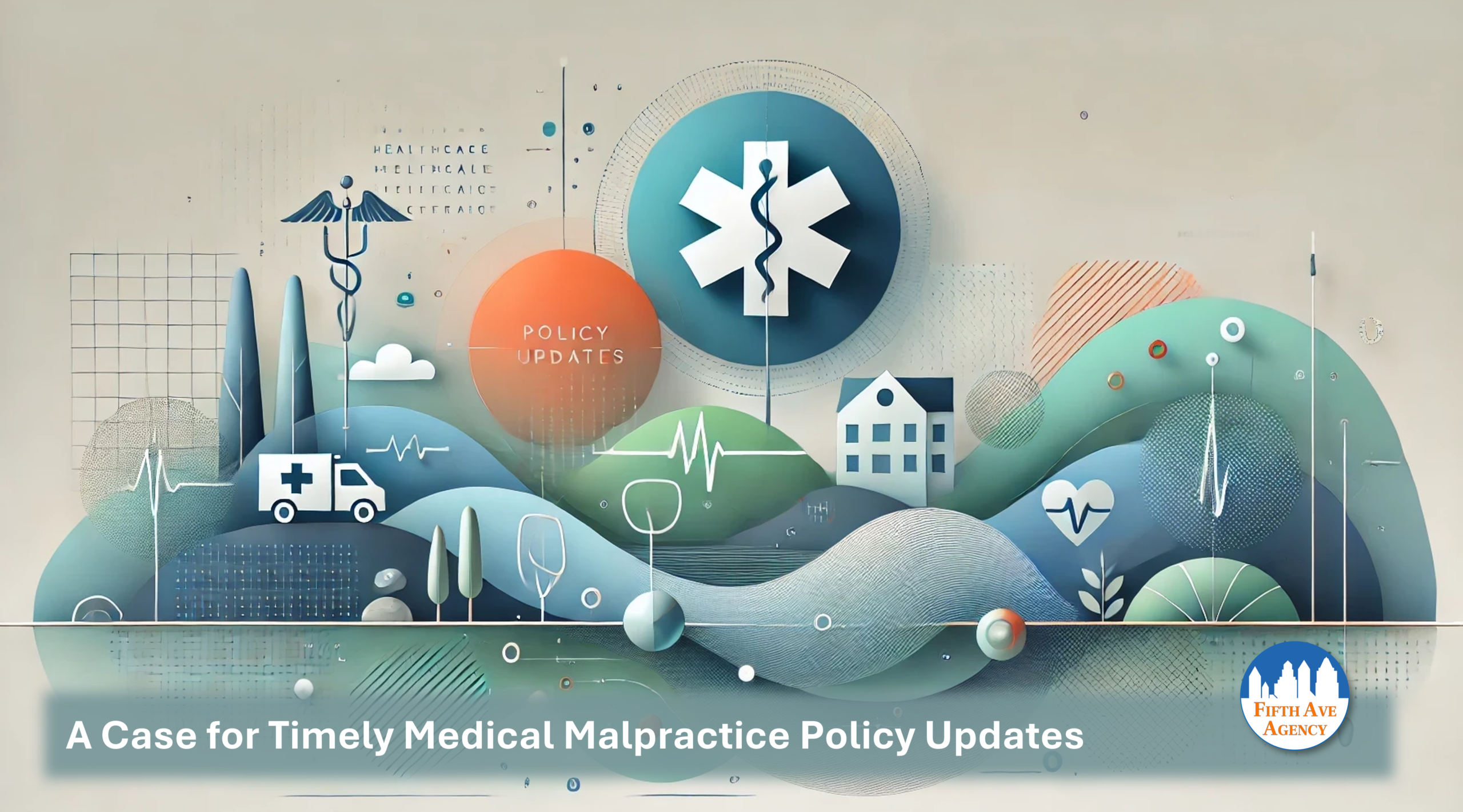As the calendar turns to 2025, healthcare providers face an ever-evolving landscape of risks, regulations, and patient expectations. The new year presents an ideal opportunity to take a proactive approach to medical malpractice coverage.
By reassessing your policy and understanding emerging trends, you can better safeguard your practice, reputation, and financial well-being. This comprehensive guide outlines the steps providers can take to strengthen their malpractice coverage for 2025.
Understanding the Current Landscape of Medical Malpractice
The healthcare industry is continuously shifting due to technological advancements, regulatory updates, and changes in patient care delivery. These factors directly influence the risks healthcare providers face.
4 key trends shaping medical malpractice in 2025
- The Rise of Telemedicine and Virtual Care: Telemedicine gained significant traction during the COVID-19 pandemic and continues to grow. However, virtual care introduces unique risks, such as cross-state licensing issues, documentation challenges, and potential misdiagnoses due to limited patient interaction.
- Artificial Intelligence in Healthcare: AI tools are revolutionizing diagnostics and treatment planning. While they offer immense potential, errors or malfunctions in AI systems could lead to liability claims. Providers must understand how AI integrates into their practice and verify coverage for related risks.
- Increased Litigation from Delayed Care: The pandemic caused many patients to defer care, leading to advanced stages of illness upon diagnosis. This has resulted in increased litigation alleging delayed or missed diagnoses, a trend expected to persist in 2025.
- Changes in Regulatory and Legal Requirements: Laws governing medical malpractice and insurance coverage vary by state and can change annually. Staying updated on these regulations is critical to maintaining compliant and comprehensive coverage. For the latest updates, refer to state-specific resources such as the National Conference of State Legislatures (NCSL).
Assessing Your Current Medical Malpractice Policy
The foundation of strong malpractice coverage is a thorough understanding of your existing policy.
Here are 5 key steps to evaluate your current medical malpractice coverage.
- Review Policy Limits: Ensure that your coverage limits align with the current costs of litigation and settlements in your state. Inflation and increasing claim payouts may necessitate higher limits than in previous years.
- Examine Coverage Scope: Confirm that your policy covers all aspects of your practice, including telemedicine, new procedures, or additional locations. Gaps in coverage could leave you vulnerable.
- Understand Exclusions: Carefully review any exclusions in your policy, such as specific procedures, types of patients, or emerging technologies like AI.
- Evaluate Tail Coverage: If you have changed practices or plan to do so, ensure you have tail coverage to protect against claims made after your prior policy’s expiration. For a detailed overview of tail coverage options, consult the American Medical Association (AMA).
- Confirm Retroactive Coverage: Retroactive coverage protects you from incidents that occurred before the start date of your current policy. This is particularly important for claims that surface years after the alleged event.
Emerging Risks in 2025 and How to Address Them
Anticipating and mitigating risks is a key component of malpractice prevention. Below are some emerging risks to watch in 2025:
Telemedicine Liability
With telemedicine becoming a mainstay, malpractice claims related to virtual care are expected to rise. Ensure your policy covers:
- Licensing issues for out-of-state patients.
- Inadequate documentation or technical errors during virtual visits.
- Potential cybersecurity breaches compromising patient data.
- For additional insights, visit Telehealth.HHS.gov.
Artificial Intelligence and Technology
AI tools are increasingly used in diagnostics, but errors in AI recommendations can lead to patient harm. Providers should:
- Verify that their malpractice insurance includes AI-related risks.
- Stay updated on regulatory guidance for AI in healthcare.
- Maintain thorough documentation of AI-assisted decisions.
- For guidance on integrating AI into healthcare safely, check the FDA’s AI/ML guidelines.
Increased Patient Expectations
Patients today are more informed and have higher expectations for their care. A failure to meet these expectations can result in lawsuits.
To mitigate this risk:
- Communicate clearly with patients about diagnoses, treatment plans, and outcomes.
- Ensure all staff members are trained in patient relations and de-escalation techniques.
Group and Hospital Liability
For providers working in group practices or hospitals, shared liability can complicate claims. Consider:
- Reviewing how liability is distributed among providers.
- Ensuring all members of the group are adequately insured.
- Establishing clear protocols for incident reporting and response.
5 Practical Steps to Strengthen Your Medical Malpractice Coverage
- Schedule a Policy Review: Work with a trusted insurance advisor to assess your current coverage and identify any gaps. A professional review can provide peace of mind and ensure your policy meets your needs.
- Stay Educated on Legal Changes: Familiarize yourself with state and federal regulatory updates that could impact your malpractice risk. Regular training and legal consultations can help you stay compliant. Resources like the Medical Professional Liability Association (MPLA) offer valuable updates and tools.
- Implement Robust Risk Management Practices: Reducing the likelihood of a malpractice claim is just as important as having strong coverage. Effective risk management includes: adopting thorough documentation practices, ensuring staff are well-trained and credentialed, and conducting regular audits of clinical processes.
- Invest in Cyber Liability Insurance: Cyberattacks are a growing concern with the rise of telemedicine and digital health records. Pairing your malpractice policy with cyber liability insurance can provide comprehensive protection. To understand the importance of cybersecurity in healthcare, visit HealthIT.gov.
- Partner with a Specialized Provider: Choose an insurer with expertise in healthcare and medical malpractice. Providers like Fifth Avenue Agency offer tailored solutions that account for the unique challenges faced by healthcare professionals. Learn more at www.fifthavenueagency.com.
The Benefits of Proactive Coverage Management
Taking a proactive approach to medical malpractice coverage offers numerous advantages, including:
- Financial Security: Comprehensive coverage minimizes out-of-pocket expenses in the event of a claim.
- Enhanced Reputation: Demonstrating a commitment to quality and accountability builds trust with patients and peers.
- Peace of Mind: Knowing you are protected allows you to focus on providing excellent patient care.
- Compliance with Industry Standards: Staying up to date ensures your practice meets legal and professional requirements.
Real-Life Example: A Case for Timely Policy Updates
In 2024, a group practice in Florida faced a malpractice claim stemming from a telemedicine visit. The provider’s policy did not cover out-of-state consultations, leaving the practice liable for a $1.2 million settlement. They could have avoided this costly outcome by updating their policy to include telemedicine coverage.
This case highlights the importance of revisiting your policy annually to address changes in your practice and the broader healthcare environment.
Conclusion: Start 2025 with Confidence
The beginning of a new year is the perfect time to reflect on your practice’s needs and fortify your medical malpractice coverage. By staying informed about emerging risks, conducting a thorough policy review, and implementing robust risk management practices, you can navigate 2025 with confidence.
Fifth Avenue Agency is here to help. Our team specializes in tailored malpractice insurance solutions that protect healthcare providers from the unexpected.
Call to Action
Don’t leave your practice vulnerable in 2025. Contact Fifth Avenue Agency today for a complimentary policy review and risk assessment. Together, we can ensure your practice is prepared for whatever the new year brings. Visit us at www.fifthavenueagency.com to get started.
More information about Fifth Avenue Agency
Fifth Avenue Agency specializes in MPLI and medical malpractice insurance, serving 1000s of providers nationwide. Fifth Avenue Agency is part of the Fifth Avenue Healthcare Services family. Sister companies include 5ACVO (credentialing and primary source verification specialists) and Primoris Credentialing Network (credentialing and provider enrollment specialists with 54+ health plan and network provider enrollment options).
Fifth Avenue Agency originally published this article here. For information on Fifth Avenue Agency, please visit FifthAvenueAgency.com or Contact Us.

















